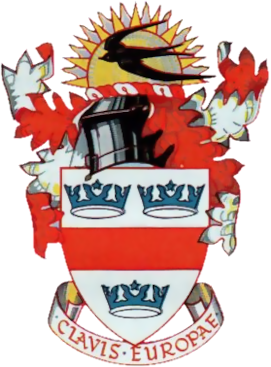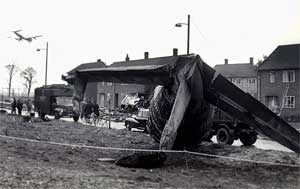
British European Airways (BEA), formally British European Airways Corporation, was a British airline which existed from 1946 until 1974.

The Vickers Vanguard was a short/medium-range turboprop airliner designed and produced by the British aircraft manufacturer Vickers-Armstrongs.
This is a list of aviation-related events from 1957.
Royal Air Force Nutts Corner, or more simply RAF Nutts Corner, is a former Royal Air Force (RAF) station located 2.7 miles (4.3 km) east of Crumlin, County Antrim, Northern Ireland and 9.2 miles (14.8 km) north west of Belfast.

Capital Airlines was a United States trunk carrier, a scheduled airline serving the eastern, southern, southeastern, and midwestern United States. Capital's headquarters were located at Washington National Airport across the Potomac river from Washington, D.C., where crew training and aircraft overhauls were also accomplished. In the 1950s Capital was the fifth largest United States domestic carrier by passenger count after the Big Four air carriers.

The Vickers VC.1 Viking is a British twin-engine short-range airliner derived from the Vickers Wellington bomber and built by Vickers-Armstrongs Limited at Brooklands near Weybridge in Surrey. After the Second World War, the Viking was an important airliner with British airlines, pending the development of turboprop aircraft like the Viscount. An experimental airframe was fitted with Rolls-Royce Nene turbojets and first flown in 1948 as the world's first pure jet transport aircraft. Military developments were the Vickers Valetta and the Vickers Varsity.

On 10 June 1960, a Fokker Friendship passenger aircraft operated by Trans Australia Airlines (TAA) was on approach at night to land at Mackay, Queensland, Australia when it crashed into the sea. All 29 people on board Trans Australia Airlines Flight 538 were killed.
SAETA Air Ecuador was a privately held airline of Ecuador, which was founded in 1966. During its heyday in the 1990s, it flew to numerous destinations in North and South America from its base in Guayaquil.

Advance Airlines Flight 4210 was a scheduled passenger flight that crashed at Sydney Airport on 21 February 1980, killing all 13 people on board the Advance Airlines Beech Beechcraft King Air 200. After taking off on runway 25 for a scheduled flight, the aircraft's left (port) engine failed, and the pilot requested an emergency landing on runway 34. The plane crashed into the seawall while attempting the emergency landing. The accident caused the greatest number of fatalities in a civil aircraft crash in Australia since MacRobertson Miller Airlines Flight 1750, a Vickers Viscount that crashed near Port Hedland in Western Australia on 31 December 1968 killing all 26 on board.

On 17 February 1959, a Turkish Airlines Vickers Viscount Type 793 on an international charter flight from Esenboğa International Airport in Ankara, Turkey, to London Heathrow Airport diverted to London Gatwick Airport, United Kingdom due to heavy fog. It was carrying the Turkish prime minister and a party of government officials. The Viscount crashed in a wood 3 miles (4.8 km) from the threshold of Gatwick runway during its final approach to land in extensive fog. Five of the eight crew and nine of the 16 passengers died in the crash. The prime minister was among the ten survivors.

British European Airways Flight 411 crashed on approach to Manchester Airport after a flight from Amsterdam Schiphol International Airport on 14 March 1957 and hit a house in Wythenshawe. All on board, 20 passengers and crew, died in the crash as did two people in the house. The aircraft involved was a Vickers Viscount registration G-ALWE operated by British European Airways. The cause of the crash was metal fatigue in flaps causing loss of control.

The 1950 Heathrow BEA Vickers Viking crash occurred on 31 October 1950 when a Vickers Viking operated by British European Airways (BEA) crashed at London Airport in heavy fog. The aircraft was on a scheduled flight between Paris and London's Northolt airport and 28 of the 30 passengers and crew on board were killed.

Ansett-ANA Flight 149 crashed near Winton in Queensland, Australia on 22 September 1966, killing all on board. The Vickers Viscount aircraft departed from Mount Isa, Queensland, Australia for a 73-minute flight to Longreach. Forty-four minutes after takeoff a fire started in one of the engines. The crew were unable to extinguish the fire or feather the propeller so made an emergency descent with the intention of landing at Winton, a small town along the route. The fire spread to the fuel tank and weakened the wing structure so that a large part of the left wing broke away and the aircraft crashed. All twenty-four occupants were killed. The accident remains the fifth-worst in Australia's civil aviation history.

On the evening of 30 November 1961, Ansett-ANA Flight 325, a service from Sydney to Canberra, Australia, operated by a Vickers Viscount 720, broke up in mid-air and crashed shortly after takeoff, when it encountered a severe thunderstorm. All 15 people on board were killed.

On 5 January 1953, a Vickers Viking airliner operated by British European Airways crashed on approach to Belfast Nutts Corner Airport, Northern Ireland. The aircraft was on a domestic flight from London Northolt Airport with 31 passengers and 4 crew on board. Twenty-four of the passengers and three crew members died in the accident.

Austrian Airlines Flight 901 was a flight from Vienna, Austria to Moscow, USSR via Warsaw, Poland. On the night of 26 September 1960, the aircraft operating the flight, a Vickers Viscount, crashed near Moscow while on its approach to land, killing 31 of the 37 passengers and crew on board.

On 25 December 1954, a British Overseas Airways Corporation Boeing 377 Stratocruiser crashed on landing at Prestwick Airport, Scotland; 28 of the 36 on board were killed.

Air Inter Flight 696Y was a scheduled revenue passenger flight from Lyon–Bron Airport to Clermont-Ferrand Auvergne Airport, France. On 27 October 1972, the aircraft operating the flight, a Vickers Viscount 724, crashed during the final approach to Clermont Ferrand Auvergne Airport. Of the 68 occupants on board, 60 perished.















